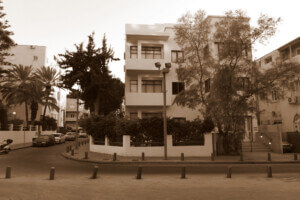As far as Western modern art pedigrees go, it’s hard to beat László Moholy-Nagy: born in Hungary 1895, Moholy-Nagy spent his early years in Budapest studying Impressionism, Cubism, and Futurism. He then traveled to Berlin where he encountered Dada and Constructivism. He was at the Bauhaus from 1923 to 28, in Amsterdam for De Stijl during the 30s, then finally London and Chicago where he founded Institute of Design (later part of IIT). He dabbled in every medium imaginable: painting, film, sculpture, typography, graphic design, theatrical set design, and architecture. But what’s most remarkable about Moholy-Nagy—and what shines through in the exhibit Moholy-Nagy: Future Present—is how consistently he explores the same themes across the breadth of his lifetime.
Moholy-Nagy was clearly enthralled with light, transparency, planes, and depth—in the words of curator Karole P. B. Vail, who spoke at the exhibit’s press preview, he was constantly trying to “materialize light” and “use light to dematerialize matter.” As the exhibition moves up the Guggenheim’s spiral, chronologically displaying his work, you can see him play with light in countless ways across multiple mediums, starting with painting and concluding with plexiglass (a material invented 1934, three years before he arrived in the US). Over 300 works, some from rarely-seen private collections, are on view. Despite their number, the works never feel densely packed. The Guggenheim spiral also has a natural affinity to Moholy-Nagy: one of his drawing/photomontages depicts a spiraling space not dissimilar from the Guggenheim itself.
Moholy-Nagy was fascinated with photography, not least because photography’s chemical process turns light into a physical image. Photography also plays with the idea of reproducibility and authenticity. Like putting a urinal into an art gallery, Dadaists love to play with conventions and challenge shared definitions of what constitutes art. That desire manifests throughout Moholy-Nagy’s work. In what he called “photoplastics,” he would collage photographs, draw over them, then photograph the ensemble anew—where does one photograph begin, the other end? Some of these pieces are genuinely absurd, and I even laughed out-loud at their Monty Python-levels of irrationality.
In another famous work on display, Moholy-Nagy designed a set of porcelain enamel-on-steel paintings whose rectangles of color were governed by a series of formulas. This meant the painting could be printed in an industrial sign shop at different sizes without distortion—infinitely reproducible, consumable, and scalable. Works like that, along with his photographic experimentation, evoke a similar question we face today: from the Venice Biennale to Palmyra, we’re still grappling with about ability to recreate artifacts. While that debate usually pertains to something lost or decayed, Moholy-Nagy flips the question on its head by starting with something intended to be infinitely duplicated.
The exhibition features one project that exists an architectural scale: the recreation of Room of the Present (Raum der Gegenwart), conceived by Moholy-Nagy in 1930 as a space to show modern artworks across all mediums—film, photography, typography, sculpture, architecture, and more. Made with gleaming steel and glass, and filled by the curators with period-appropriate avant-garde works, it does feel like a time capsule from the past. It’s no coincidence that the room is made from industrial materials: Moholy-Nagy was an avid experimenter. Gropius brought him to the Bauhaus precisely because his focus on modern materials coincided with the school’s move toward creating and licensing designs to industry. From metallic paint to early plastics, it’s stimulating to watch Moholy-Nagy play with new materials as they appear over the decades.
The exhibition text concludes “Moholy-Nagy was always in pursuit of the “whole man,” seeking out new materials and methods in the steadfast belief that what mattered most were intellectual awareness and the necessity for the assimilation of art, technology, and education.” As Vail remarked, he was a “truly utopian artist” who thought technology could improve society, though he was a true humanist as well. As Moholy-Nagy himself said, there was a “specific need of our time for a vision in motion.”
As technology—smartphones, 3D printing, virtual reality, self-driving cars—rapidly changes our lives, and tech companies sell us on their utopian, people-friendly vision, we should ask: What exactly does a techno-humanist-utopia look like? The exhibit offers bracing insight into Moholy-Nagy lifetime of art-making, but leaves us to contemplate what Moholy-Nagy’s vision for a utopian society looked like.
Moholy-Nagy: Future Present will be at the Guggenheim from May 27 to September 7 before traveling to LACMA and the Art Institute of Chicago. Karole P. B. Vail, Curator, is the Guggenheim’s organizing curator for the exhibition, with the assistance of Ylinka Barotto, Curatorial Assistant, and Danielle Toubrinet, Exhibition Assistant.










